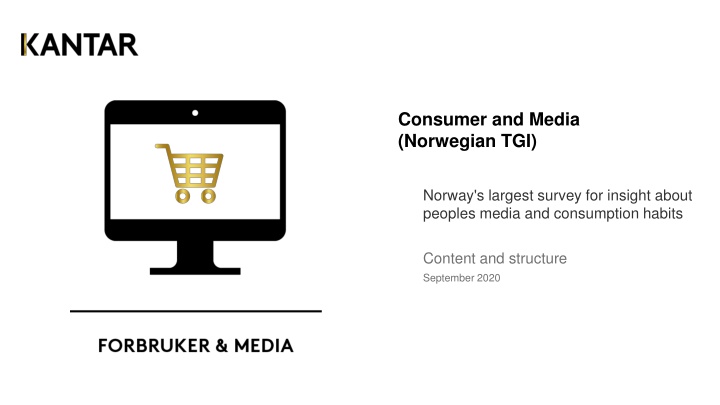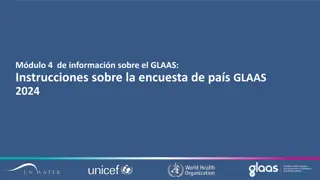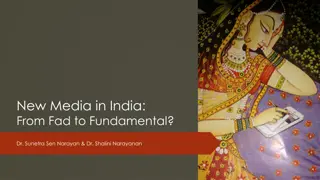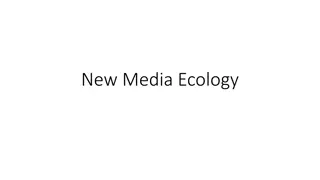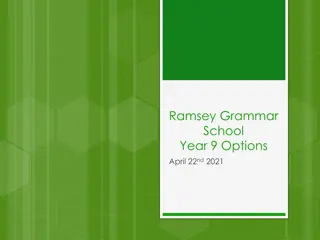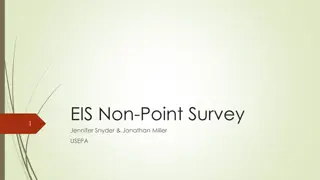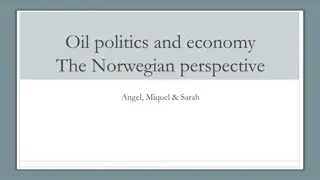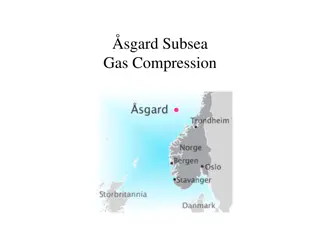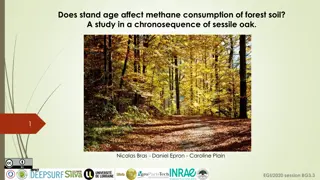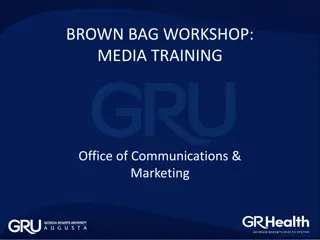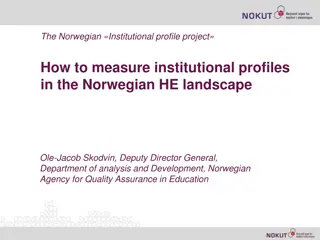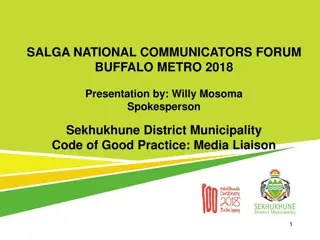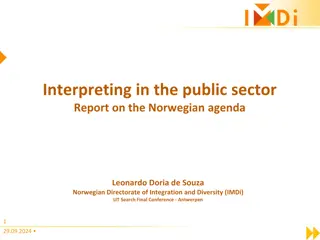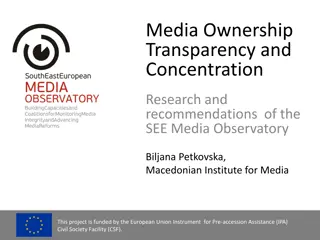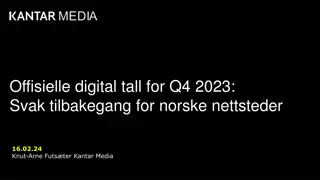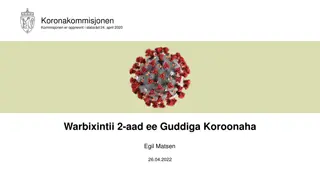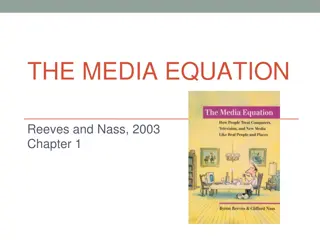Norwegian TGI Survey: Media & Consumption Insights
Norway's largest survey, Consumer and Media (Norwegian TGI), provides deep dives into media and consumption habits, offering data on lifestyle, brand preferences, and more. Established in 1988, it conducts 45,000 yearly interviews, covering 960 media brands and 1,900 brands across 175 categories. The survey is a valuable tool for agencies, brand owners, and authorities seeking market insights and media selection guidance. With continuous content updates and comprehensive data on consumer behavior, Consumer and Media (Norwegian TGI) offers invaluable insights for targeted marketing campaigns.
Download Presentation

Please find below an Image/Link to download the presentation.
The content on the website is provided AS IS for your information and personal use only. It may not be sold, licensed, or shared on other websites without obtaining consent from the author.If you encounter any issues during the download, it is possible that the publisher has removed the file from their server.
You are allowed to download the files provided on this website for personal or commercial use, subject to the condition that they are used lawfully. All files are the property of their respective owners.
The content on the website is provided AS IS for your information and personal use only. It may not be sold, licensed, or shared on other websites without obtaining consent from the author.
E N D
Presentation Transcript
Consumer and Media (Norwegian TGI) Norway's largest survey for insight about peoples media and consumption habits Content and structure September 2020
Consumer & Media The Norwegian Target Group Index (TGI) Norway s largest survey about peoples media usage and consumption habits Do you want to understand the media- and consumption patterns of your target group? Or maybe you want to know what is the profile of your current customers? Or maybe you want to know which media are most relevant in order to reach consumers that consider brand as one of the alternatives to buy? Consumer & Media, (the Norwegian TGI*), is Norway s largest survey and data is collected continuously through the year. It gives you the possibility to compare different individual media towards each other, and to compare media usage directly with the consumers lifestyle, consumption habits, brand preference, purchasing plans, decision responsibilities at work, demographics and geographic. It is an important tool for media- and creative agencies, brand owners and governmental authorities for market and target group insights, and for selecting media in an advertising campaign. Data are presented in a software and you can have access to usage of the data through subscription, or we can tailor a report based on your current needs. About Consumer & Media Established in 1988. Continuous updating of content to prevail relevance for insight deep dives. 45 000 yearly interviews. Measures approx. 960 individual media brands/titles. Measures brand awareness and preference for approx. 1.900. brands across 175 categories. Measuring 120 attitude statements, 90 interests and 40 activities. 2 *TGI = Target Group Index and an asset of Kantar
Consumer and Media (C&M) / Target Group Index (TGI) Norway s largest consumer & multimedia study The C&M study contains two parts Media usage: newspapers, radio, internet, TV, cinema Background demographics: age, sex, nationality, household/personal income, household size, geography, education No. of respondents i) C&M CATI Survey Gathers data from 45.000 respondents on media usage as well as holding demographic information. The study includes official usage data for newspapers, radio, internet, TV and cinema. 45.000 CATI Survey Media usage Interests and activities Attitudes and opinions Consumption and spend Ownership and purchase intentions Brands: Durables, FMCG and services Awareness, preference, use most often or own today Professional role and business decision making Shopping centers and local stores Segmentation tools ii) C&M TGI Approx. 15.000 CATI respondents also complete some but not all sections of a TGI questionnaire. All 15.000 complete a general section which includes questions relating to media usage (e.g. magazines), supplementary demographic information, attitudes and lifestyle. 30.000 15.000 TGI (Self completion Cawi or paper) No. of variables 3
TGI content and sampling procedure (1) CATI / Recruitment interview Demography, geography and media usage General and Common part: Interests and activities, attitudes and opinions, editorial content, streaming and digital behavior, work status, family background, spending in categories, shopping habits and purchase decisions, shopping centers PART 1 PART 2 Durables Category information: Fmcg and other non-capital goods Category information: Consumption, food & beverages, cosmetics, cleaning and toiletries, clothes, shoes, paint, grocery and convenience stores, gas stations, shopping centers, retail stores visits, etc. Ownership and purchase intentions, electronics, telecommunication, computer, mobile phones, bank & insurance, tourism/travel/leisure, furniture, building materials, interior materials, garden/flowers, children toys and equipment, cars, charity, lottery/gaming, retail stores visits, etc. BRANDS BRANDS fmcg and other non-capital goods (Brand Awareness, Brand Preference, Brand Use most often) Food and beverage, household products, personal care, clothing and shoes, stores and retail chains, etc. durables and services (Brand Awareness, Brand choice, Brand ownership) Cars, white goods, telephone companies, mobile phones, real estate agents, bank/insurance, credit cards, restaurants, hotels, tourism, transportation, media, energy, health and training, stores and retail chains, etc 4
MEDIA INDEXES: Newspapers MARKET AND CONSUMER INDEXES: Lifestyle The official readership figures for newspapers including both paper and digital readership. Statements that describes peoples attitudes, opinions and outlook on life as well as their interests and activities they take part in. This section is the main foundation for the different segmentation models that are developed. Magazines The official readership figures for magazines including both paper and digital readership. Consumption Questions about peoples consumption patterns, spending on different products and services, and shopping habits. In this section we have included Opinion Leadership and Word of Mouth categorizations. TV Access and daily viewing of TV in total and individual channels. Including Heavy-Medium-Light viewing groups. (incl. Cinema!) Access and daily listening to Radio in total and individual channels. Including Heavy-Medium-Light listener grouping. Access and daily usage of Internet in total and loyalty of usage of individual sites. Including Heavy-Medium-Light user groups. Radio Durables Ownership and purchase intentions of different types for durables/capital goods and services. Travel, holiday, banking, insurance also folds into this index. Internet Brands Awareness, preference and usage of a variety of different brands within different product categories across fmcg, services and durables. The information is presented in different graphical tools Information about occupation and professional life. Business sector/industry, company size, title and position, decision-making responsibility and/or influence in different product categories. Work and decision making Regional Awareness, preference and usage of local shopping centers in different areas of Norway. Information about interests in different content categories in media in general and in specific media channels. Online surf and search behavior. Segmentation based on sociology and the theories of the French sociologist Pierre Bourdieu where family background and upbringing are important factors. Lifestyle segmentation model based on attitudes, activities and interests Kantar TGI global segmentation model based on 32 standardized attitude statements on different subjects. Editorial Sosioraster Kompass LifeValues OCEAN Kantar TGI model of calculating the The Big Five personality traits (Openness, Conscientiousness, Extroversion, Agreeableness, Neuroticism) Moasic is a sosiogeographic segmentation model with global presence. 13 Mosaic segments and the 44 underlaying Mosaic types are available for analysis and insight in C&M. Mosaic 5
Key facts Consumer & Media Study Norwegian TGI Consumer & Media survey at a glance: In Consumer & Media (Forbruker & Media) we have approx. 5.800 variables in the TGI part of the survey and 2.500 in the CATI part, There is a single source recruitment from the CATI to the TGI (web/postal) part of the study. Overall we have approx. 8.300 variables altogether per respondent. Categories and Brands: 173 Categories (36 shop/retail categories, 29 categories of services, 108 product categories) 1.897 Brands (293 shops, 311 services companies, 1.293 product brands) Lifestyle: Attitudes, interests and activities Attitude statements: 120 Interests: 92 Activities/doings: 40 6
2. Segmentation and market models within Consumer & Media (TGI Norway) 7
Segmentation models within TGI Norway Different segmentation solutions The software Gallup PC contains all the C&M data, including different segmentation tools for analysis purposes. The different segmentation solutions are 1. Compass 2. Life Values (Kantar global modell) 3. Sosioraster 4. Connected Life (Kantar global model) 5. Word Of Mount index (WOM) 6. Early Adopters 7. Media Consumption Index (H, M, L) 8. Generations 9. Mosaic 10. OCEAN (Kantar global model) Applications: Identify and describe target groups, communication strategies and media planning 8
1. Compass Lifestyle segmentation based on attitudes, interests and activities Segmentation methodology Two main dimensions and 9 segments Example on graphical output - Usage of cheese brand TINE Norvegia The segmentation tool is based on the idea that the personal attitudes and actions of individuals in a society will follow given patterns. - Red: high indexed segments - Blue: Low indexed segments Modern The two main dimensions in the Compass: - Dimension 1: Community Individuality 1 Distribution of the population - Dimension 2: Modern Traditional 2 8 In Compass the population are divided into 9 segments. 3 Community oriented 7 9 Individually oriented The method being used to create the two dimensions, and consequently the 9 segments, is Principal Component Analysis (PCA), base on different subjective variables: 4 6 5 - Interests and activities: sport, culture, music, technology and media. Traditional - Opinions and attitudes towards different subjects: risk and regularity, environmental and economical issues, shopping and consumption habits, level of solidarity and cultural and economic liberalism in the society. 9
01 Modern (12 %) Male 20-49 yrs. Old (the youngest segment) Education: Many students Income: Low or high (students low) Interested in popular music, shopping, electronics, movies & series. Like trying new things, follows fashion trends, brand conscious. Thrill seekers, like challenges. Active online (social media, looking for brands/services, search), Activities: video gaming, team sports, jogging, watching sports on TV, outgoing (nightclubs/bars). 02 Modern Individually Oriented (9 %) Male 20-49 yrs. old Education: Many students Income: Low or high (students low) Thrill seekers. pro privatization and market-economic management in the society, brand conscious, like to try new things before others. Politically right wing. Concerned about their careers. Interested in technology, fashion, shopping, gaming and cars. Activities: Active in sports both as spectators and participants. Often go to the pub/bar/nightclub. 08 Modern Community Oriented (9 %) Male 20-49 yrs. old Education: High Income: Low to medium (students low) Environmentally conscious and socially engaged, trendsetter, fashion interested. Quality-conscious consumers. Internet is an important news source. Activities: festivals/concerts, opera/theater, library, art exhibitions and museums, going out (nightclubs/bars), climbing, running, team sports. Compass Segment description 07 Community oriented (12 %) Women 40-59 yrs. old Education: High Income: Medium to high Community engaged, interested in culture, quality and environmentally conscious. Focus on organic food, good ingredients and a healthy diet, likes food from different parts of the world. Listens to classical music, jazz and folk music. Activities: cultural venues, religious events, hiking, cross-country skiing. 06 Traditional Community Oriented (9 %) Women 60-79 yrs. old Education: High Income: Low to medium Tradition, moral, safety seekers, cautious consumers, many religious, fond of Norwegian products, environmentally conscious, engaged in family and health. Generally interested in culture. Newspapers (local and national), radio and television. Listens to opera, jazz and danseband . Activities: go to the theater, museums, library, opera and art exhibitions, religious events. Not very interested in physical exercise. 09 Moderate (16 %) 40-49 yrs. old Education: Medium to high Income: Medium to high 03 Individually Oriented (12 %) Male 30-49 yrs. old Education: Low Income: Medium to high Materialistic, like new technology, pro privatization and market-economic management in the society. Not very interested in fashion and culture. Price conscious. Activities: Hunting and fishing, watching sports on TV, not very interested in physical exercise. Mainstream. Medium socially engaged. Interested in work, home and family. Activities: golf, hunting, fishing, cross country skiing and general exercise / training. 04 Traditional - Individually Oriented (9 %) 50-79 yrs. old Education: Low Income: Low Price conscious. pro privatization and reduction of social security and foreign aid, like well-known brands. Seeks safety and like routines. Listen the danseband music, country and roots. Politically right+ wing. Traditional media dominates. Activities: Hunting and fishing, but not very interested in physical exercise. 05 Traditional (12 %) Women 60-79 yrs. Old (the oldest segment) Education: Low Income: Low (many pensioners) Tradition, safety seekers, like regularity and order. Loyal customers. Cost and quality conscious consumers. Interested in gardening, sports on TV and enjoy folk music and danseband music. Traditional media use, newspapers very important, reading magazines. Activities: Fishing, walks, hiking, religious events. 10
2. Life Values segmentation Lifestyle segmentation based on the transcultural Schwartz Theory of Basic Human Values Summary overview of the segments The model and it s segments 11
3. Sosioraster Segmentation based on sociology Segmentation methodology Two main dimensions and 9 segments Example on graphical output - Preference to cheese brand TINE N kkelost The segmentation tool is based on the French cultural sociologist Pierre Bourdieu's study and his book La Distinction.. - Segment size and index value High volume The two main dimensions in the Sosioraster: - Dimension 1: Cultural capital Economic capital 1 Distribution of the population - Dimension 2: Low volume High volume 2 8 In Sosioraster the population are divided into 9 segments (social fields with homogeneous groups ) based on their economic and cultural capital. 3 Cultural capital 7 9 Economical capital 4 Multiple Correspondence Analysis (MCA) is used to create the two dimensions, and consequently the 9 segments, from objective background variables: 6 5 - Position of Brand and main competitors - total value of car(s)/boat(s)/house(s)/secondary home(s) and other assets, household income, heritage cultural capital (grew up in a home with encyclopedia/ piano/ foreign books/chess), level of education, subject areas education, private/public school, occupation, occupation private/public sector, level of education and occupation of parents). Low volume 12
High volume Male 20-49 yrs. old Education: High Income: High Politics: Labor and Right Gallup Compass: Modern and/or Community oriented. Work: private sector, administrative/HR, consulting, IT, research. High volume - Culture Women 20-39 yrs. old Education: High Income: Low Politics: Labor, highest share of voters for Green Party Gallup Compass: Modern Community oriented. High volume - Economy Male 40-59 yrs. old Education: High Income: High Politics: Right Gallup Compass: Modern and/or Individually Oriented Sosioraster Segment description Highest cultural capital Subject areas higher education: medicine, law, science, philosophy, history. Work: public sector, education, research. Highest share of students. High cultural capital Subject areas higher education: economy, technical. Work: private sector, IT, economy. Highest share of managers/CEO s. High volume, Cult. (9 %) High volume, Econ. (9 %) High volume (12 %) Culture Women 20-49 yrs. old Education: Medium to high Income: Low Politics: Labor, highest share of voters for Red Alliance. Gallup Compass: Modern and/or Community oriented. Economy Male 40-69 yrs. old Education: Medium to high Income: High Politics: Labor, Right Gallup Compass: Individually Oriented. Moderate 20-49 yrs. old Education: Medium to high Income: Medium to high Politics: Labor Gallup Compass: Evenly distributed among the segments, but with lower shares within the Traditional segments. Moderate (16 %) Culture (12 %) Economy (12 %) The segment with the highest share of men. Subject areas higher education: economy, technical. Work: private sector, economy. High share of managers/CEO s. High cultural capital Subject areas higher education: health care, society. Work: public sector, health care, education. Mainstream. Low volume, Econ. (9 %) Low volume, Cult. (9 %) Low volume (12 %) Low volume - Economny Male 50-69 yrs. old Education: Low to medium Income: Medium to high Politics: Labor, highest share of voters for Right++ Gallup Compass: Traditional or Individually oriented Low volume - Culture Women 40-69 yrs. old Education: Low to medium Income: Low Politics: Labor Gallup Compass: Evenly distributed among the segments, but with lower shares within the Modern segments. The segment with the highest share of women. Subject areas higher education: health care. Work: public sector, health care. High share of pensioners. Low volume 40-69 yrs. old Education: Low to medium Income: Medium to high Politics: Labor Gallup Compass: Traditional or Individually oriented Low cultural capital High share of persons with secondary school as their highest education level. Work: private sector, production, logistics, crafts. Highest share of pensioners. Lowest cultural capital High share of persons with secondary school as their highest education level. Work: private sector, production, logistics, crafts. High share of pensioners. 13
4. Connected Life Segmentation based on digital influence and social media engagement Background and methodology Two main dimensions and five segments* Description of the five segments SUPER LEADERS Within the leader segment the most active and most social group of all. Likely to be the earliest of adopters, the influencers and the trend setters. Connected Life segmentation classifies the population into five segments based on their level of digital influence and engagement in social media. The model stems from Kantars Connected Life study and has being recreated using existing variables within Consumer & Media SUPER LEADERS High (10%) LEADERS The most digitally, and socially active of all the segments. They may be online as much as the Observers, but they are highly social, creating and sharing content, and engaging with brands. DIGITAL INFLUENCE The two dimensions in Connected Life are:: OBSERVERS (19%) LEADERS (22%) - Dimension 1: Low to high digital influence - Dimension 2: Low to high social engagement CONNECTORS Spend a limited time online, but when they are, they are heavily social. Principal Component Analysis (PCA) are used to create the two dimensions, and consequently the five segments, from variables measuring digital media usage and social media engagement: FUNCTIONALS Spend the least time online either through choice, or lack of access. Will often use online where there is a tangible advantage, but are the slowest to adopt new trends. They are the least social of all the groups. - Freq. of use: internet, social media, internet through smart phone/tablet and streaming services. Where to access internet: home/work/school/other places. Freq. of downloading music/films/series, looking for and reading reviews on products/services online, reading/writing blogs, participate in chatting/ discussions, comment/share/like/retweet. FUNCTIONALS (29%) CONNECTORS (20%) Low OBSERVERS Spend a lot of time online, but are less open to engaging with brands in a social space. Low High SOCIAL ENGAGEMENT Global Kantar model *segment sizes and descriptions as for Norway in The Connected Life Study 2017/2018 14
5. Word of Mouth and Opinion Leadership Classification of consumers in different product groups according to their knowledge, persuasiveness and interaction with others Background and Methodology Four segments and 12 product categories Description of the segments CONNECTORS Connectors are super social and talk to many about their areas of interest. With a large network and a social competence they are a good starting point for a campaign. The WOM index maps out opinion leaders within specific categories. Opinions leaders are people who have an ability and a willingness to spread messages and influence other people's behaviors through their views and advice. The models background can be found in two-step flow of communication model that says most people form their opinions under the influence of opinion leaders, who in turn are influenced by the mass media (Paul Lazarsfeld et al. 1944). SALESMEN A Salesman is a person with a strong knack for persuasion in the category. Salesman are individuals who like to persuade their environment of products pros and cons. They are likely to convince others about their opinions. MAVENS Mavens has the deepest knowledge in the category and who could give a large amount of information about a product. They search for information and are happy to share of their superior knowledge. They are helpful and a good source if you need good advice. - Based on questions about social skills, innovation willingness and interest in new products, TOGETHER with questions about how updated or interested a respondent are in different categories, we are able to define three segments for each category; Connectors, Salesmen and Mavens. (ref. Malcolm Gladwell, The Tipping Point, 2000). The ones who classifies into all segments are defined as Champions (Opinion Leaders). The segmentation is done in these specific categories: CHAMPIONS These are people who falls into all the above-mentioned segments. Hence, they are a group that talk to many different people, could give a large amount of information, and are likely to convince others about their opinions. Food and beverage Health, Cosmetics Clothing & shoes Leisure and Travel Automotive Interior, house and home Occupation / Profession Economy Electronics Politics and society Cosmetics TV, Radio & music equipment - The different WOM segments can help amplify an advertising campaign and/or product launch significantly through f2f communication or social media. In today s digital world this can happen much faster than before because of social media. 15
6. Diffusion and Adopters Categorization of consumers based on innovativeness Background Adoption Curve Diffusion and adoption theory In addition to the Word of Mouth segmentation we have made a general innovation model to identify different categories of adopters. Derived from Diffusions of Innovations , Everett Rodgers, 1962. Diffusion of innovations is a theory that seeks to explain how, why, and at what rate new ideas and technology spread. Everett Rogers, a professor of communication studies, popularized the theory in his book Diffusion of Innovations; the book was first published in 1962. According to this established theory, the criterion for the adopter categorization is innovativeness, defined as the degree to which an individual adopts a new idea. The model is constructed from questions about how often the respondents search for information about new products and services, look out for new things and their willingness to try things before their friends. Rogers argues that diffusion is the process by which an innovation is communicated over time among the participants in a social system. The model divides the population into five different Adoption Groups with predefined sizes given from the Diffusions of Innovations theory: Early Majority (34 %) Late Majority (34 %) No./% Rogers proposes that four main elements influence the spread of a new idea: the innovation itself, communication channels, time, and a social system. Early Adopters (13 %) - Innovators (3 %) This process relies heavily on human capital. The innovation must be widely adopted in order to self- sustain. Within the rate of adoption, there is a point at which an innovation reaches critical mass. Laggards (16 %) - Early Adopters (13 %) Innovators (3 %) - Early Majority (34 %) Time - Late Majority (34 %) - Laggards (16 %) Source: Wikipedia 16
7. Media Consumption A topline view of media consumption Background and media measurement Daily reach Heavy Medium Light users - Categorization of users of a media channel into three approximate equally split groups There are many different media titles being measured in Consumer & Media for all media channels 0.0 20.0 40.0 60.0 80.0 Newspaper (online) Online (mobile) TV Broadcast total Online (desktop) Radio total Commercial TV Streaming Direct Mail* Newspaper (print) - Based on media usage questions we seek to allocate users into three equally split groups; 1/3 light, 1/3 medium and 1/3 heavy users - TV, radio, newspapers, online newspapers, magazines, web magazines, other online sites, streaming services, social media, direct mail, outdoor, cinema and more - The individual media brands we measure spans from national through regional to local. Total population (%) Age 15-29 Affinity Index Media consumption comparison Outdoor Commercial Radio Online (tablet) Magazines Cinema** - Most media we measure are computed for media planning/scheduling purposes down to specific titles. For analytical purposes and target group insights we have constructed two types of aggregated media indexes; 1) Daily reach, and 2) Heavy-Medium-Light usage. Low Medium High Low Medium High TV Radio Newspaper Magazines Internet Streaming Cinema 32 32 32 31 33 36 31 33 33 33 34 32 33 37 36 35 35 35 35 30 32 205 172 160 171 47 14 34 76 89 99 88 28 45 47 48 Podcast Blogg 120 99 109 131 204 155 SoMe Total - Both can be used for better understanding of a target group s use of different media channels in addition to other characteristics. Facebook Snapchat Instagram Twitter Linked In 17
3. Marketing models within Consumer & Media (TGI Norway) 18
Marketing models within TGI Norway Different solutions for market overview, identifying market challenges and classification of consumers The software Galileo contains all the C&M data, including different market insight tools for analysis purposes. The different marketing models are: 1. Market Map 2. Communication Map 3. Push Pull Applications: Identify and describe target groups, develop communication strategies and perform media planning. 19
Market map Identifies the unsolved communication tasks for a brand (fmcg and other short-term goods) Melke-/drikkeprodukter: Oatly Havredrikke BRAND: Oatly (milk oatdrink) The Market Map divides consumers of fmcg, short term goods and shops into groups based on their awareness and experience with a particular brand. The model was an invention by the Norwegian Otto Ottesen in 1977 who then worked as a professor at Copenhagen Business School. Forbruker & Media '19/2 - NOVEMBER(19) - MGI Nedbrytning: Hele befolkningen/100,0% 4 205,704 (13 845) M lgruppe: Hele befolkningen (4 205,704 / 100,0% / 13 845 resp.) 44% Aware 56% - Kjenner ikke 56% Unaware 44% - Kjenner 2% - Foretrekker 2% - Preference 10% - Indifferent 10% - Indifferent 20%- Have tried The map builds on the simple assumption that a brand needs to be known to consumers, tried and a preferred choice for customers to become loyal. Brand awareness and rial are the starting points. Then it is central to know how consumers perceive the brand. The map helps marketeers to detect which areas to focus on to stimulate brand growth. 20% - Pr vet 8% - Forkaster 8% - Rejects 24% - Ikke pr vet 24% - not tried Input variables for The Market Map: Trial share: 46% Share preference: 12% Share indifferent: 50% Brand Awareness Trial Evaluation (preference, indifferent or rejection) Andel Pr vet: 46 Andel Foretrekker: 12 Andel Indifferent: 50 Andel Forkastet: 39 Share rejection: 39% 20
Communication map Identifies the unsolved communication tasks for a brand (durables/capital goods) BRAND: iPAD The Communication Map divides consumers of durables and capital goods into groups based on their awareness and evaluation of a particular brand. For durables we usually do not see repetitive repurchase. A consumers own experience are therefore quite limited. Information about brand consciousness and if it is part of a consumers evoked set are of vital importance for a marketeer. It is vital for a marketeer to have a clear picture of this context in order to put in place an effective communication strategy. Awareness 88% Will Choose 36% The model breaks down the path to purchase from brand awareness, via brand consideration, to purchase intention. The input variables for The Market Map are: Unaware: 12% Aware Evoked set: 30% Evoked Set Will Choose: 22% Brand Awareness Evoked set (consideration set) Will choose (purchase intention) Evoked Set 58% (will consider) 21
Push/Pull Looks at the relation between market share vs. purchase intention or brand preference GROCERY CHAINS/STORES Market share The Push/Pull analysis puts the attention towards the distance between purchase intention or brand preference and the market share of different brands in a category. Hence we can also see the relative position for brands in a product category. PULL In TGI the purchase intention or brand preference represent the PULL axis of the graphic. Market share (measured as brand last bought or brand use most often ) represents the PUSH axis. Push position: A brand positioned above the 45-degree diagonal line has a market share that is not reflected in the underlying purchase intention or brand preference. A typical price leader will have such a position. The position can be vulnerable IF a brand is challenged on it s price and/or distribution advantage. Pull position: A brand positioned below the 45-degree diagonal line has a purchase intention or brand preference that is higher than the acquired market share.Typically this is the position for premium brands that often are able to charge a higher price than other brands. PUSH preference 22
About Kantar Our mission is to make our clients smarter. We believe that well-thought out and fact-based decisions win over decisions made by pure gut feeling. That s why we have studied the Norwegian market since 1946, and helped our clients make well-informed decisions, based on what really happens in their market. Kantar is the world s leading evidence-based insights and consulting company. We have a complete, unique and rounded understanding of how people think, feel and act; globally and locally in over 90 markets. By combining the deep expertise of our people, our data resources and benchmarks, our innovative analytics and technology, we help our clients understand people and inspire growth. In total we are over 30.000 engaged employees worldwide, where 120 are based in Norway. In Norway our fieldwork organization of Norsk Gallup Institutt AS are a 100% owned subsidiary of Kantar.
Syndicated media surveys from Kantar Norway TVOV MEASUREMENT (TV CURRENCY) INTERBUS (Digital trends TGI) MEDIA YOUTH CONSUMER & MEDIA 24 THE MEDIA DIARY SOCIAL MEDIA TRACKER FUNCTIONALITY OF MEDIA AND CHANNEL USAGE HOUSEHOLDS MEDIA COSTS MAGAZINE READERSHIP (NRS) MEDIA CHILDREN NEWSPAPER READERSHIP (NRS) PROFESSIONAL PRESS 24
25 25
